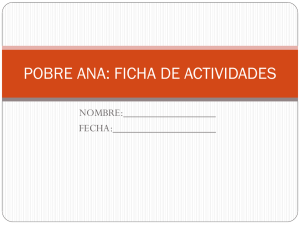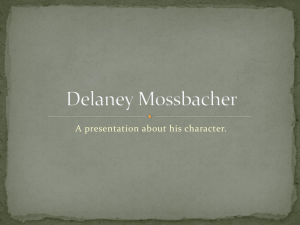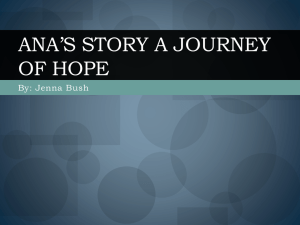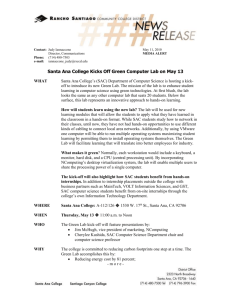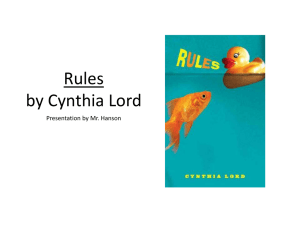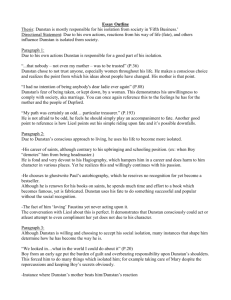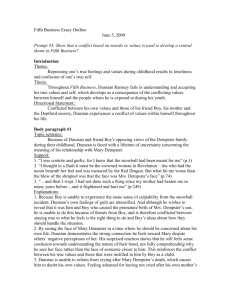Pre-show notes Neighbourhood Watch – State Theatre Adelaide
advertisement
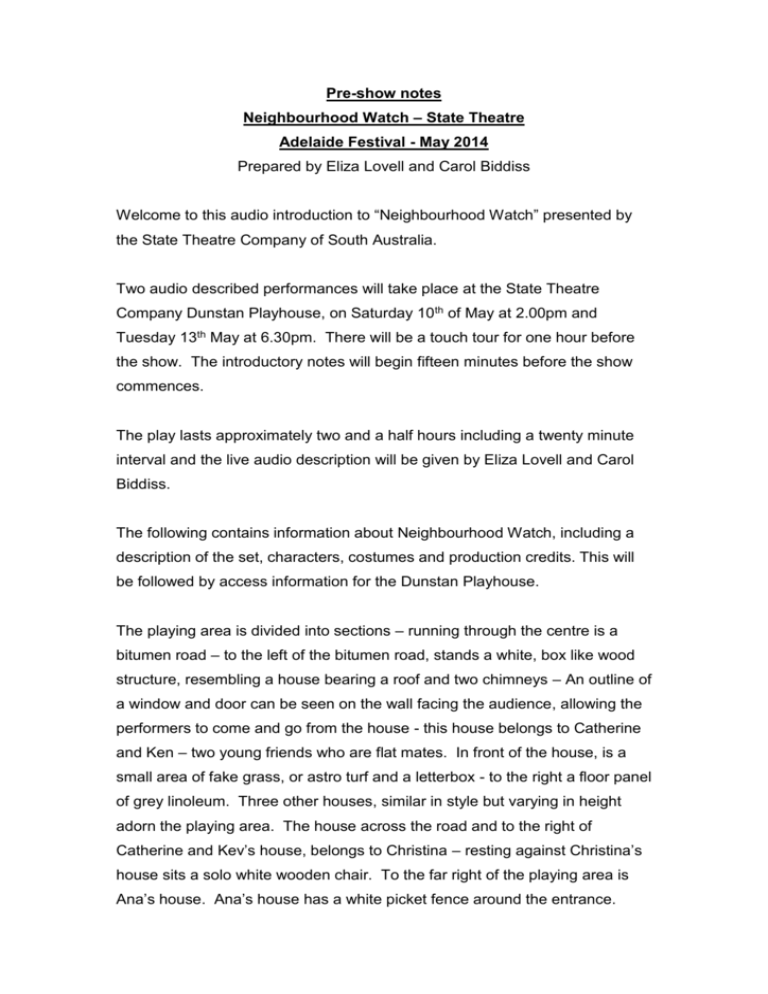
Pre-show notes Neighbourhood Watch – State Theatre Adelaide Festival - May 2014 Prepared by Eliza Lovell and Carol Biddiss Welcome to this audio introduction to “Neighbourhood Watch” presented by the State Theatre Company of South Australia. Two audio described performances will take place at the State Theatre Company Dunstan Playhouse, on Saturday 10th of May at 2.00pm and Tuesday 13th May at 6.30pm. There will be a touch tour for one hour before the show. The introductory notes will begin fifteen minutes before the show commences. The play lasts approximately two and a half hours including a twenty minute interval and the live audio description will be given by Eliza Lovell and Carol Biddiss. The following contains information about Neighbourhood Watch, including a description of the set, characters, costumes and production credits. This will be followed by access information for the Dunstan Playhouse. The playing area is divided into sections – running through the centre is a bitumen road – to the left of the bitumen road, stands a white, box like wood structure, resembling a house bearing a roof and two chimneys – An outline of a window and door can be seen on the wall facing the audience, allowing the performers to come and go from the house - this house belongs to Catherine and Ken – two young friends who are flat mates. In front of the house, is a small area of fake grass, or astro turf and a letterbox - to the right a floor panel of grey linoleum. Three other houses, similar in style but varying in height adorn the playing area. The house across the road and to the right of Catherine and Kev’s house, belongs to Christina – resting against Christina’s house sits a solo white wooden chair. To the far right of the playing area is Ana’s house. Ana’s house has a white picket fence around the entrance. This, is Mary Street - a small inner city community/ suburb in Sydney, New South Wales. Catherine and Ana’s house open out, as if you are opening a card – a stagehand performs this. Inside Catherine’s house, the walls are white – an ironing board and a white plastic washing basket is brought on and off. The inside of Ana’s house, is her lounge room - it is detailed, neat, quaint and pretty – the skirting boards are white and a couple of vintage, white frames and mirrors hang on the light blue walls. A white, wrought iron round table stands up against the wall – sitting on this small table is a 1950’s record player, a neatly stacked pile of books and a glorious bunch of colored roses – ones you might find growing in an avid gardeners yard. A birdcage rests against the wall, as does a pile of books. An armchair with a matching round cushion in a vintage floral fabric sits to the right of her lounge room. At the back of the playing area is a white screen, throws a blue hue – it’s a sunny day on Mary Street. The actors are responsible for set changes between scenes – many objects are used to denote environment for example, a hospital screen, black sulo wheelie rubbish bins, Kev’s macintosh lap top computer – the use of chairs placed in various configurations also resemble a particular location, such as the local Neighbourhood watch meeting, doctors room, a street in Hungary, a train or local cinema or bus stop. Characters and Costumes The cast includes 7 performers (four women and three men). All of the actors except Miriam Margolyes play multiple roles in street scenes and flashbacks. Characters include various Mary St visitors – a neighbourhood watch volunteer, a grocery home delivery man, a postie, a police officer. For the flashback scenes set in Hungary – Ana’s family, a gypsy, soldiers, Ana’s family friend Artur, populate Ana’s stories. Miriam Margolyes plays a widow, Ana, a Hungarian woman of some eighty years. She lives on a quiet suburban street with her German Shepherd dog, Bella. She is distinctively short, rotund and walks with difficulty. Her manner is lively and her face unsmiling. Her mid-length frizzy hair is grey. She wears her jewellery consisting of a gold watch and diamond rings. She wears neat, high buttoned dresses with bold floral prints on a dark background, half stockings that stop at mid calf, large orthopaedic sandals in a cream colour and occasionally a hand-knit bright pink cardigan. In the mall scene, she dresses in a bright red coat with a blue dress underneath and black “serious” shoes. She wears pockets in her dresses and when going out carries a large black handbag from which she likes to brandish bank notes. Eleanor Stankiewicz plays twenty-something Catherine and also plays a younger version of Ana. By contrast to Ana, she is extremely tall and slender. She has a beautiful face and long blonde hair plaited into a contemporary stylish wreath around her head. She is an unemployed actor and she sits in a dreamy state or moves about listlessly carrying a mobile phone. She wears a onesie, or frayed shorts over tights and ugg boots when she is lounging around at home. Later she appears in a fresh sunshine yellow skirt with a dark blue top and crisp white collar while short white socks top her brown ankle boots. This look is later transformed into a wartime white nurses outfit by donning a white pinafore and white mask. Carmel Johnson plays the character of Christina, another neighbour of Ana. Christina is a middle-aged woman who appears hale and hearty at the start dressed in day clothes but wearing a scarf tied up around her head. She is always busy, either beating dust out of a floor mat or sweeping. James Smith takes the role of Ken, the diabetic housemate of Catherine. He is a film–maker and is currently in limbo waiting for funding. He has an even, open face and short brown hair. He is a little shorter than Catherine and has a wistful yet eager way of moving. He dresses casually in jeans and t-shirts and usually carries his lap-top computer around with him, swinging it from one hand. Nic English plays Martin, Catherine’s erstwhile lover. Martin has a long handsome face, dark hair and eyes and he is slightly taller than Catherine. Martin wears a dark suit and is neatly dressed. Nic English also plays the handsome chemist and the Woolworths delivery boy. Milova is played by Eugenia Fragos - Milova is in her late seventies and walks with immense difficulty, her back stooped, knees bent, feet angled out in her startling gold sandals. She wears old-fashioned dull coloured clothing, a full head-scarf tied under the chin, which she lifts as she speaks. Milova carries several shopping bags. Eugenia Fragos also plays the doctor. She is elegant and upright with her grey hair hanging loosely onto her shoulders. Ben Roberts appears in many non-speaking roles such as the Postman. Creative Credits Writer: Lally Katz Director: Julian Meyrick Assistant Director – Sarah Dunn Set and Costume Designer: Louise Mc Carthy Lighting Designer: Geoff Cobham Composer/ Sound Designer: Quincy Grant Access Information Access Information Public Transport: The Playhouse Theatre is located in The Adelaide Festival Centre. The Adelaide Festival Centre is a short walk from the Adelaide Railway Station. You can also catch the Tram from Glenelg or Adelaide Entertainment Centre and alight at a stop on North Terrace. Parking: There is parking available on Festival Drive - you can enter off King William Road. The car park is equipped with a lift and ramps, which are accessible from all car park spaces. To pre-book your disability space please call BASS on 131 246. Bookings must be made no later than 12 noon the day before the park is required or by Friday 12 noon for a weekend car park. Drop Off Point: You can be dropped off at the Dunstan Playhouse & Space Theatre Entrance on Festival Drive - enter from King William Road. Accessible seating: Seating will be reserved for patrons using audio description equipment. Accessible toilets: Available in the Dunstan Playhouse Foyer Bar Location(s): Bars are located in the Space Foyer, Dunstan Playhouse Foyer & Bistro. Please enquire at the Drama Centre Information Desk, located in the Playhouse foyer for lift access to The Bistro. If you would like to know about Access2Arts you can contact Gaelle Mellis at A2A on: gaelle@access2arts.org.au This document has been prepared by Eliza Lovell and Carol Biddiss for Access2Arts and is correct at the time of recording in May 2014.

